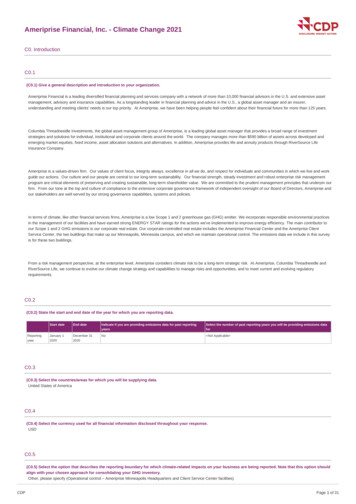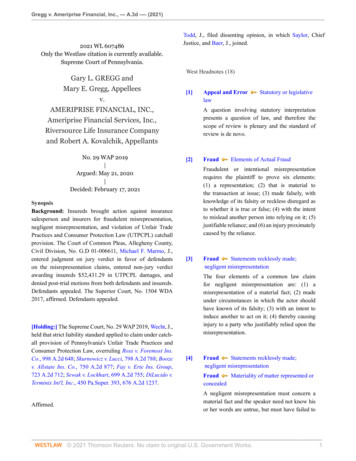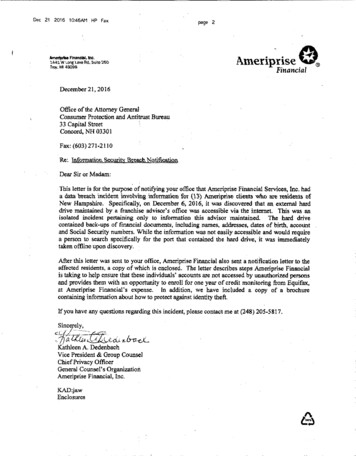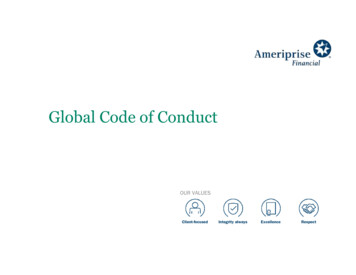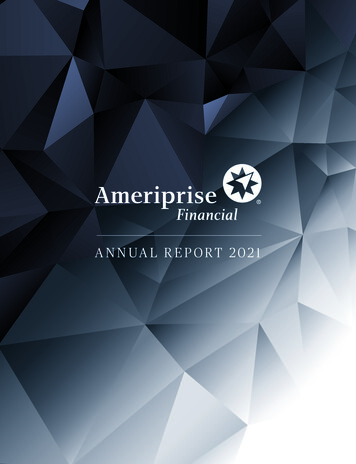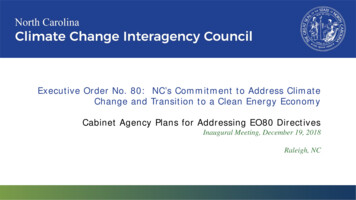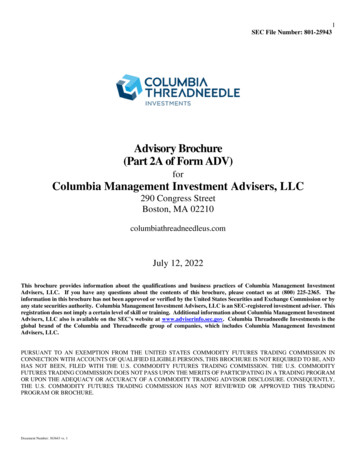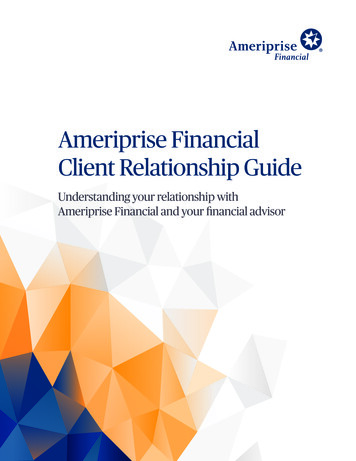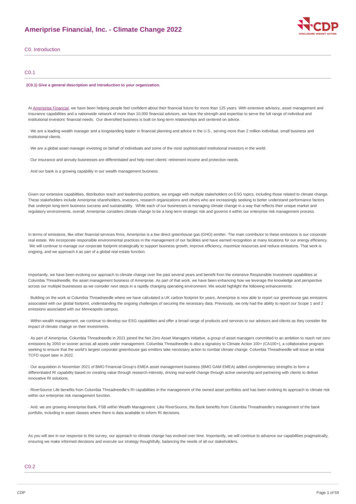
Transcription
Ameriprise Financial, Inc. - Climate Change 2022C0. IntroductionC0.1(C0.1) Give a general description and introduction to your organization.At Ameriprise Financial, we have been helping people feel confident about their financial future for more than 125 years. With extensive advisory, asset management andinsurance capabilities and a nationwide network of more than 10,000 financial advisors, we have the strength and expertise to serve the full range of individual andinstitutional investors' financial needs. Our diversified business is built on long-term relationships and centered on advice.· We are a leading wealth manager and a longstanding leader in financial planning and advice in the U.S., serving more than 2 million individual, small business andinstitutional clients.· We are a global asset manager investing on behalf of individuals and some of the most sophisticated institutional investors in the world.· Our insurance and annuity businesses are differentiated and help meet clients' retirement income and protection needs.· And our bank is a growing capability in our wealth management business.Given our extensive capabilities, distribution reach and leadership positions, we engage with multiple stakeholders on ESG topics, including those related to climate change.These stakeholders include Ameriprise shareholders, investors, research organizations and others who are increasingly seeking to better understand performance factorsthat underpin long-term business success and sustainability. While each of our businesses is managing climate change in a way that reflects their unique market andregulatory environments, overall, Ameriprise considers climate change to be a long-term strategic risk and governs it within our enterprise risk management process.In terms of emissions, like other financial services firms, Ameriprise is a low direct greenhouse gas (GHG) emitter. The main contributor to these emissions is our corporatereal estate. We incorporate responsible environmental practices in the management of our facilities and have earned recognition at many locations for our energy efficiency.We will continue to manage our corporate footprint strategically to support business growth, improve efficiency, maximize resources and reduce emissions. That work isongoing, and we approach it as part of a global real estate function.Importantly, we have been evolving our approach to climate change over the past several years and benefit from the extensive Responsible Investment capabilities atColumbia Threadneedle, the asset management business of Ameriprise. As part of that work, we have been enhancing how we leverage the knowledge and perspectiveacross our multiple businesses as we consider next steps in a rapidly changing operating environment. We would highlight the following enhancements:· Building on the work at Columbia Threadneedle where we have calculated a UK carbon footprint for years, Ameriprise is now able to report our greenhouse gas emissionsassociated with our global footprint, understanding the ongoing challenges of securing the necessary data. Previously, we only had the ability to report our Scope 1 and 2emissions associated with our Minneapolis campus.· Within wealth management, we continue to develop our ESG capabilities and offer a broad range of products and services to our advisors and clients as they consider theimpact of climate change on their investments.· As part of Ameriprise, Columbia Threadneedle in 2021 joined the Net Zero Asset Managers initiative, a group of asset managers committed to an ambition to reach net zeroemissions by 2050 or sooner across all assets under management. Columbia Threadneedle is also a signatory to Climate Action 100 (CA100 ), a collaborative programseeking to ensure that the world’s largest corporate greenhouse gas emitters take necessary action to combat climate change. Columbia Threadneedle will issue an initialTCFD report later in 2022.· Our acquisition in November 2021 of BMO Financial Group’s EMEA asset management business (BMO GAM EMEA) added complementary strengths to form adifferentiated RI capability based on creating value through research intensity, driving real-world change through active ownership and partnering with clients to deliverinnovative RI solutions.· RiverSource Life benefits from Columbia Threadneedle’s RI capabilities in the management of the owned asset portfolios and has been evolving its approach to climate riskwithin our enterprise risk management function.· And, we are growing Ameriprise Bank, FSB within Wealth Management. Like RiverSource, the Bank benefits from Columbia Threadneedle’s management of the bankportfolio, including in asset classes where there is data available to inform RI decisions.As you will see in our response to this survey, our approach to climate change has evolved over time. Importantly, we will continue to advance our capabilities pragmatically,ensuring we make informed decisions and execute our strategy thoughtfully, balancing the needs of all our stakeholders.C0.2CDPPage 1 of 59
(C0.2) State the start and end date of the year for which you are reporting data.ReportingyearStart dateEnd dateIndicate if you are providing emissions data for past reportingyearsSelect the number of past reporting years you will be providing emissions dataforJanuary 12021December 312021Yes2 yearsC0.3(C0.3) Select the countries/areas in which you c of KoreaSingaporeSpainSwedenSwitzerlandUnited Arab EmiratesUnited Kingdom of Great Britain and Northern IrelandUnited States of AmericaC0.4(C0.4) Select the currency used for all financial information disclosed throughout your response.USDC0.5(C0.5) Select the option that describes the reporting boundary for which climate-related impacts on your business are being reported. Note that this option shouldalign with your chosen approach for consolidating your GHG inventory.Operational controlC-FS0.7(C-FS0.7) Which activities does your organization undertake, and which industry sectors does your organization lend to, invest in, and/or insure?Does your organization undertake this activity?Insurance types underwritten Industry sectors your organization lends to, invests in, and/or insuresBanking (Bank)Yes Not Applicable Exposed to all broad market sectorsInvesting (Asset manager)Yes Not Applicable Exposed to all broad market sectorsInvesting (Asset owner)Yes Not Applicable Exposed to all broad market sectorsInsurance underwriting (Insurance company)YesLife and/or Health Not Applicable C0.8(C0.8) Does your organization have an ISIN code or another unique identifier (e.g., Ticker, CUSIP, etc.)?CDPIndicate whether you are able to provide a unique identifier for your organizationProvide your unique identifierYes, a Ticker symbolAMPYes, an ISIN codeUS03076C1062Yes, a SEDOL codeBYZHDR1Yes, a CUSIP number03076C106Page 2 of 59
C1. GovernanceC1.1(C1.1) Is there board-level oversight of climate-related issues within your organization?YesC1.1a(C1.1a) Identify the position(s) (do not include any names) of the individual(s) on the board with responsibility for climate-related issues.Position of Please explainindividual(s)Board-levelcommitteeThe Nominating and Governance Committee of the Ameriprise Financial Board of Directors oversees the firm's enterprise-level corporate social responsibility (CSR) efforts. The Committee reviewsand discusses with senior management the content of the Company’s annual CSR report and any proposed material revisions to the report, as well as shareholder feedback, the evolving practices inthe financial services industry in the United States, and the company’s related policies and reporting metrics. Our 2022 Responsible Business Report includes information on our climate positioningand risk management processes and is available at /ampcom/2022-responsible-business-report.pdf Our approach to climate and consideration asa long-term strategic risk also ensures that climate change is incorporated within overall risk discussion and oversight.ChiefExecutiveOfficer(CEO)Our chairman and CEO leads the company's Executive Leadership Team Corporate Social Responsibility Steering Committee (ELT CSR SteerCo). The ELT CSR SteerCo meets quarterly to reviewCSR initiatives and priorities and make decisions related to CSR programs and evolution. This includes our climate-related strategy. In consultation with the ELT CSR SteerCo, our Chief Risk Officerand the Corporate Social Responsibility Working Group (CSR Working Group), the CEO helps drive climate positioning and related risk management processes. CSR Working Group membershipincludes senior leaders from Corporate Communications, Community Relations, Human Resources, Investor Relations, Real Estate, Responsible Investment at Columbia Threadneedle, RiskManagement, and our General Counsel's Organization, including our Corporate Secretary. Ultimately, decisions about how the company will continue to evolve our climate strategy, actions anddisclosures, are made by the CEO, Chief Risk Officer and members of the Executive Leadership Team.C1.1b(C1.1b) Provide further details on the board’s oversight of climate-related issues.Frequencywithwhichclimaterelatedissues areascheduledagendaitemGovernance Scope ofPlease explainmechanisms board-levelinto whichoversightclimaterelatedissues areintegratedScheduled Reviewing– someand guidingmeetingsstrategyReviewingand guidingmajor plansof actionReviewingand guidingriskmanagementpoliciesReviewingand guidingbusinessplansOverseeingmajor er, pleasespecifyClimaterelated risksandopportunitiesto our ownoperationsThe impactof our ownoperationson theclimateThe Board of Directors reviews Corporate Social Responsibility (CSR) initiatives, programs, performance and strategy at Ameriprise. The Nominating and GovernanceCommittee of the Ameriprise Board oversees our CSR efforts, including our climate-related initiatives. For example, at the January 2022 meeting, the committee reviewedthe Ameriprise Responsible Business Report, which includes our climate-related strategy and work. The Lead Independent Director also participates on certain investorcalls that address climate change risk management and disclosures. In addition, the Audit & Risk Committee oversees all risk management activities, which include thecompany's determination of climate as a long-term strategic risk. Management regularly updates the Board on the regulatory environment and emerging risks. The Boarddiscusses with management, the general auditor and independent auditors the company’s enterprise-wide risk assessment and risk management processes, including: Prevailing material risks and exposures Actions being taken to mitigate these risks The design and effectiveness of our processes and controls in light of evolvingmarket, business, regulatory and other conditions.C1.1d(C1.1d) Does your organization have at least one board member with competence on climate-related issues?Board member(s) havecompetence on climaterelated issuesRow Not assessed1CDPCriteria used to assess competence of Primary reason for no board-level Explain why your organization does not have at least one board member withboard member(s) on climate-relatedcompetence on climate-relatedcompetence on climate-related issues and any plans to address board-levelissuesissuescompetence in the future Not Applicable Not Applicable Not Applicable Page 3 of 59
C1.2(C1.2) Provide the highest management-level position(s) or committee(s) with responsibility for climate-related issues.Name of the position(s) and/or committee(s)Reporting lineResponsibilityCoverage of responsibilityFrequency of reporting to theboard on climate-related issuesChief Executive Officer (CEO)Reports to the board directlyAssessing climate-related risks andopportunitiesRisks and opportunities related toour investing activitiesRisks and opportunities related toour insurance underwriting activitiesRisks and opportunities related toour own operationsAnnuallyChief Risks Officer (CRO)CEO reporting lineAssessing climate-related risks andopportunitiesRisks and opportunities related toour own operationsAs important matters ariseOther, please specify (Vice President, Global RealEstate)Finance - CFO reporting lineBoth assessing and managingclimate-related risks andopportunitiesRisks and opportunities related toour own operationsNot reported to the boardChief Investment Officer (CIO)Investment - CIO reporting lineAssessing climate-related risks andopportunitiesRisks and opportunities related toour investing activitiesNot reported to the boardOther, please specify (Columbia ThreadneedleResponsible Investment leadership)Investment - CIO reporting lineBoth assessing and managingclimate-related risks andopportunitiesRisks and opportunities related toour investing activitiesNot reported to the boardFacility managerFinance - CFO reporting lineManaging climate-related risks andopportunitiesRisks and opportunities related toour own operationsNot reported to the boardCorporate responsibility committeeOther, please specify (AmeripriseCorporate Social Responsibility WorkingGroup)Both assessing and managingclimate-related risks andopportunitiesRisks and opportunities related toour investing activitiesRisks and opportunities related toour insurance underwriting activitiesRisks and opportunities related toour own operationsNot reported to the boardOther, please specify (RiverSource Life RiskManagement)Other, please specify (Reports to head ofRiverSource Life subsidiary)Assessing climate-related risks andopportunitiesRisks and opportunities related toour insurance underwriting activitiesNot reported to the boardOther, please specify (Executive Leadership TeamCorporate Social Responsibility Steering Committee)CEO reporting lineBoth assessing and managingclimate-related risks andopportunitiesRisks and opportunities related toour investing activitiesRisks and opportunities related toour insurance underwriting activitiesRisks and opportunities related toour own operationsAnnuallyC1.3(C1.3) Do you provide incentives for the management of climate-related issues, including the attainment of targets?Provide incentives for the management of climate-related issuesRow 1 YesCommentNon-monetary recognition relates to our facilities team and are associated with energy efficiency projects, as detailed below.C1.3a(C1.3a) Provide further details on the incentives provided for the management of climate-related issues (do not include the names of individuals).Entitled to incentiveType of incentiveActivity incentivizedCommentFacilities managerNon-monetary rewardEnergy reduction projectOur real estate team receives recognition for energy reduction initiatives in performance reviews.Please selectPlease selectPlease selectC-FS1.4(C-FS1.4) Does your organization offer its employees an employment-based retirement scheme that incorporates ESG criteria, including climate change?Employment-based retirement scheme thatincorporates ESG criteria, including climatechangeRow Yes, as an investment option1Describe how funds within the retirement scheme are selected andhow your organization ensures that ESG criteria are incorporatedProvide reasons for not incorporating ESG criteria into yourorganization’s employment-based retirement scheme and your plans forthe futureA broad selection of ESG strategies are available through our selfdirected brokerage option. Not Applicable C2. Risks and opportunitiesC2.1CDPPage 4 of 59
(C2.1) Does your organization have a process for identifying, assessing, and responding to climate-related risks and opportunities?YesC2.1a(C2.1a) How does your organization define short-, medium- and long-term time horizons?From (years)To (years)CommentShort-term01Realized risks are also sometimes defined within a 0-18 month timeframe.Medium-term13Long-term3100C2.1b(C2.1b) How does your organization define substantive financial or strategic impact on your business?Ameriprise considers climate as a long-term strategic risk within our Enterprise Risk Management (ERM) process. Within this framework, the Enterprise Risk ManagementCommittee (ERMC) provides oversight for firm-wide strategic, financial and operational risk. While the enterprise considers climate a strategic risk, increased scrutiny maybe taking place across individual business units based on their business and regulatory requirements.Through our ERM process, the company evaluates substantive financial impacts on a quarterly basis. Each business unit identifies and assesses material operational risks aspart of the RCSA process. We use a Red, Amber, Green (RAG) rating system to classify Risk Events (REVs) on a scale of very low to very high actual or potential impact.Each REV is assigned an impact rating based on the RAG status, and determined by the actual or potential financial, business, client, regulatory, and reputational impact.Business unit leads score each risk on three dimensions: probability of occurrence, financial impact and control environment.Consideration of climate risk within the ERM process began in 2020 and continues to evolve over time.C2.2(C2.2) Describe your process(es) for identifying, assessing and responding to climate-related risks and opportunities.Value chain stage(s) coveredDirect operationsUpstreamRisk management processIntegrated into multi-disciplinary company-wide risk management processFrequency of assessmentAnnuallyTime horizon(s) coveredMedium-termDescription of processAt the enterprise level, Ameriprise considers climate risk to be a long-term strategic risk. The company reviews long-term strategic risks on an ongoing basis, and formallyreviews them as part of our enterprise risk management process annually. In addition, the company reviews strategic risk and the actions to mitigate the potential impact ofthose risks as part of our long-range planning process. Our enterprise risk management process includes assessing, protecting against and mitigating the physical risks ofcatastrophic weather events affecting the company, our clients and our policyholders. And we are cognizant of the long-term transitional challenges and opportunities thatreflect evolving consumer preferences and regulatory regimes. Overall, we approach climate issues as a wealth manager, global asset manager and insurer: Within wealthmanagement, we continue to develop our ESG capabilities and offer a broad range of products and services to our advisors and clients as they consider the impact ofclimate change on their investments. This includes expanded research, training and tools for advisors. Our asset management business, Columbia Threadneedle, is aResponsible Investment leader, and our extensive fundamental research reflects our belief that prudent management of financial and ESG factors are important to acompany’s ability to create long-term, sustainable value. Within our retirement and protection business, our efforts related to climate change strategy are both part ofAmeriprise's engagement process, and as a responsible investor within life portfolios. Ameriprise, and its subsidiaries, Columbia Threadneedle and RiverSource Life,continue to evolve their climate approach and capabilities to manage risks and opportunities, as well as meet current and evolving regulatory requirements. We would alsonote the growth of Ameriprise Bank within our Wealth Management business.C2.2aCDPPage 5 of 59
(C2.2a) Which risk types are considered in your organization's climate-related risk assessments?Relevance Please ncludedAs a diversified financial services firm, our businesses are heavily regulated. Virtually all aspects of our business, including the activities of our parent company and our subsidiaries, aresubject to various federal, state and international laws and regulations. Compliance with these applicable laws and regulations is time consuming and personnel-intensive, and we haveinvested and will continue to invest substantial resources to ensure compliance by our parent company and our subsidiaries, directors, officers, employees, registered representatives dOur businesses are regulated heavily, and changes to the laws and regulations applicable to our businesses, including those pertaining to climate, may have an adverse effect on ouroperations, reputation and financial condition. In addition, climate change regulation may affect the prospects of companies and other entities whose securities we hold, or our willingnessto continue to hold their securities. Further, any future legislation or changes to the laws and regulations applicable to our businesses, as well as changes to the interpretation andenforcement of such laws and regulations, may affect our operations and financial condition. An example of emerging regulation is the SEC's proposed climate reporting rule.Technology Relevant,alwaysincludedTechnology is a key component of our business, and any risk would be assessed against the ability to deliver the technology component of that particular area, including climate. As anexample, physical risks related to technology infrastructure are considered annually when IT conducts a risk assessment, vertically and horizontally across the organization.LegalRelevant,alwaysincludedAs a financial services firm, our operations are generally not subject to climate or environmentally related litigation claims. However, we are, and in the future may be, subject to legal andregulatory actions in the ordinary course of our operations, both domestically and internationally.MarketRelevant,alwaysincludedOur financial condition and results of operations may be materially affected by market fluctuations and by economic and other factors, including climate. Such factors, which can be global,regional, national or local in nature, include: (i) the COVID-19 pandemic, or any variation thereof; (ii) political, social, economic and market conditions; (iii) the availability and cost of capital;(iv) the level and volatility of equity prices, commodity prices and interest rates, currency values and other market indices; (v) technological changes and events; (vi) U.S. and foreigngovernment fiscal and tax policies; (vii) U.S. and foreign government ability, real or perceived, to avoid defaulting on government securities; (viii) the availability and cost of credit; (ix) theongoing inflationary environment; (x) investor sentiment and confidence in the financial markets; (xi) terrorism and armed conflicts; and (xii) natural disasters such as weather catastrophesand widespread health emergencies. These factors could also impact client behavior. Market downturns, stagnation, and volatility may cause, and have caused, individual investors to limitor decrease their participation in global markets negatively impacting our retail business and/or our product sales. We monitor evolving industry trends to inform our business strategy andidentify market risks, which may include changes in client demand. As ESG investment trends evolve, clients may be interested in allocating a higher percentage of their investments toResponsible Investment (RI)/Environmental, Social and Governance (ESG) strategies and solutions over time.Reputation Relevant,alwaysincludedA failure to protect our reputation could adversely affect our businesses. Our reputation is one of our most important assets. Our ability to attract and retain customers, investors,employees and advisors is highly dependent upon external perceptions of our company, as well as our culture that drives engagement. Climate change may also influence investorsentiment with respect to the Company and investments in our portfolio. It may also impact other counterparties, including reinsurers, and affect the value of investments, including realestate investments we hold or manage for others. To help mitigate reputational risks related to climate, our investors are increasingly monitoring opportunities and risks related to RI/ESGstrategies, recognizing that the field is evolving to one that combines an expectation of improved performance related to sustainability factors and alignment with one's values. Additionally,Ameriprise maintains environmental transparency through its Responsible Business Report and participation in this survey.AcutephysicalRelevant,alwaysincludedClimate change is increasing the severity and frequency of weather-related catastrophes, which may adversely affect our investment portfolio or investor sentiment. The occurrence ofnatural disasters and catastrophes, including earthquakes, hurricanes, floods, tornadoes, fires, blackouts, severe winter weather, explosions, pandemic disease (such as COVID-19) andman-made disasters, including acts of terrorism, riots, civil unrest including large-scale protests, insurrections and military actions, could adversely affect our results of operations orfinancial condition. Such disasters and catastrophes may damage our facilities, preventing our service providers, employees and financial advisors from performing their roles, or otherwisedisturbing our ordinary business operations and by impacting insurance claims, as described below. These impacts could be particularly severe to the extent they affect access to physicalfacilities, the physical well-being of large numbers of our employees, our computer-based data processing, transmission, storage and retrieval systems and destroy or release valuabledata. Such disasters and catastrophes may also impact us indirectly by changing the condition and behaviors of our customers, business counterparties and regulators, as well as bycausing declines or volatility in the economic and financial ate change is increasing the severity and frequency of weather-related catastrophes, or adversely affect our investment portfolio or investor sentiment. The potential effects of naturaland man-made disasters and catastrophes on certain areas of our businesses include but are not limited to the following: (i) a catastrophic loss of life may materially increase the amount ofor accelerate the timing in which benefits are paid under our insurance policies; (ii) an increase in claims and any resulting increase in claims reserves caused by a disaster may harm thefinancial condition of our reinsurers, thereby impacting the cost and availability of reinsurance and the probability of default on reinsurance recoveries; (iii) widespread unavailability of staff;and (iv) declines and volatility in the financial markets that may decrease the value of our assets under management and administration, which could harm our financial condition andreduce our management fees. Additionally, our real estate team monitors chronic shifts in climate that may affect the facilities in our operational footprint. For example, severe weather suchas heat waves, winter weather or severe seasonal storms may impact our energy efficiency.C-FS2.2b(C-FS2.2b) Do you assess your portfolio’s exposure to climate-related risks and opportunities?We assess the Explain why your portfolio's exposure is not assessed and your plans to address this in the futureportfolio'sexposureBanking(Bank)No, and we donot plan to inthe next twoyearsThe vast majority of our Bank's investment portfolio is invested in structured assets, including mortgages. Columbia Threadneedle manages the portfolio and has extensive RIcapabilities, including with regard to managing the risks and opportunities related to climate risk. However, there is a lack of reliable, consistent data available for these assetclasses. As the market matures and relevant data capabilities develop further, we will continue to evaluate our ability to assess the portfolio's exposure.Investing(Assetmanager)Yes Not Applicable InvestingYes(Asset owner) Not Applicable Insuranceunderwriting(Insurancecompany)As a life insurer and annuity provider our underwriting is at the retail/client level, and therefore we don't incorporate climate risk at the policy level. However, we continue toadvance our climate capabilities largely within our insurance investment portfolio and within our risk management approach.No, and we donot plan to inthe next twoyearsC-FS2.2cCDPPage 6 of 59
(C-FS2.2c) Describe how you assess your portfolio’s exposure to climate-related risks and opportunities.Type of risk ProportionType ofTimeTools andmanagement of portfolio assessment horizon(s) methodsprocesscovered bycoveredusedriskmanagementprocessProvide the rationale for implementing this process to assess your portfolio's exposure to climate-related risks andopportunitiesBanking(Bank) NotApplicable Investing(Assetmanager)Investing(Assetowner) NotApplicable Not NotApplicable Applicable Not Applicable Integrated100into multidisciplinarycompanywide rt-termMediumtermLong-termRisk modelsScenarioanalysisStress testsInternaltools/methodsOther, pleasespecify(Aladdin /MSCI)Given the number of portfolios we cover as a risk team, we start with quantitative screens to identify potential risks. We thenincorporate qualitative data in our discussions with the portfolio managers. We’re constantly looking to improve the process, justas we are also evolving how we look at RI and climate change within the firm overall. An advantage of using these methods isthat we are able to assess the analysis that portfolio managers are doing, alongside an independent view. A disadvantage iswe also utilize external data, and we know that some of this isn’t always reliable. Following Columbia Threadneedle’s adoptionof a net zero goal, we are rolling out a Net Zero data tool, which will enhance our analysis by providing data on how wellaligned our companies are to a net zer
insurance capabilities and a nationwide network of more than 10,000 financial advisors, we have the strength and expertise to serve the full range of individual and . been evolving our approach to climate change over the past several years and benefit from the extensive Responsible Investment capabilities at Columbia Threadneedle, the asset .
